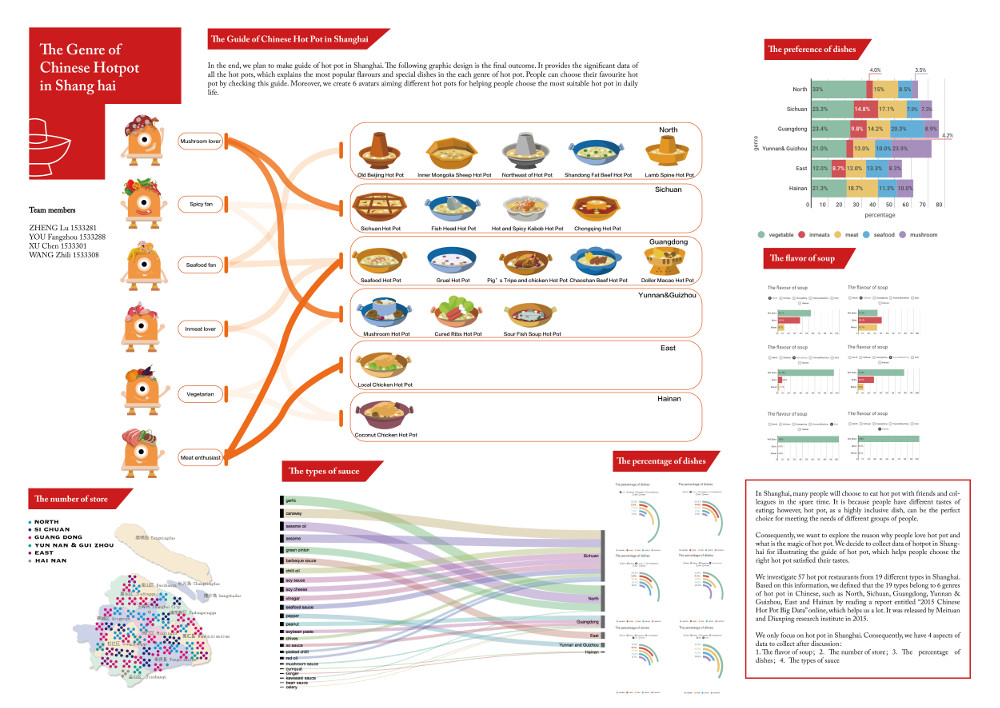A Guide to Hotpots in Shanghai
In Shanghai, many people will choose to eat hot pot with friends and colleagues in the spare time. It is because people have different tastes of eating; however, hot pot, as a highly inclusive dish, can be the perfect choice for meeting the needs of different groups of people. Consequently, we want to explore the reason why people love hot pot and what is the magic of hot pot. We decide to collect data of hotpot in Shanghai for illustrating the guide of hot pot, which helps people choose the right hot pot satisfied their tastes.
About the Chinese Hotpots
First and foremost, we use google to collect the history of hot pot. Hot pot - is the most famous dish in
China. Hot pot consisting of a simmering metal pot of stock at the center of the dining table. While the
hot pot is kept simmering, ingredients are placed into the pot and are cooked at the table. Typical hot
pot dishes include thinly sliced meat, leaf vegetables, mushrooms, wontons, egg dumplings, and
seafood. The cooked food is usually eaten with a dipping sauce. Hot pot meals are usually eaten in the
winter during supper time.
 The Chinese hot pot has a history of more than 1,700 years. Hot pot seems to have originated in
Mongolia where the main ingredient was meat, usually beef, mutton or horse. It then spread to southern
China during the Tang Dynasty and was further established during the Mongolian Yuan Dynasty. In
time, regional variations developed with different ingredients such as seafood. By the Qing Dynasty
(AD 1644 to 1912), the hot pot became popular throughout most of China. Today in many modern
homes, particularly in the big cities, the traditional coal-heated steamboat or hot pot has been replaced
by electric, gas or induction cooker versions.Because hot pot styles change so much from region to
region, many different ingredients are used.
The hot pot developed gradually, adapting to historical introduction of vessels, social demands and
ingredients, just like China’s dietary development. For instance, it was impossible to have spicy hot pot
before huajiao (pricklyash peel) and chili peppers were introduced to China. During the Three
Kingdoms period, Emperor Wendi of Wei noted the “Five-Section Vessel” which could be used to
cook different foods at the same time. This vessel is similar to today’s “2 in 1 Hot Pot.” In the Southern
and Northern Dynasties, bronze was the most common vessel, which gradually evolved into today’s
hot pot.
Furthermore, based on this information, we defined that there are 6 genres of hot pot in Chinese, such
as North, Sichuan, Guangdong, Yunnan & Guizhou, East and Hainan by reading a report entitled
“2015 Chinese Hot Pot Big Data” online, which helps us a lot. It was released by Meituan and
Dianping research institute in 2015. We only focus on hot pot in Shanghai. And we have 4 aspects of data to collect after discussion.
The Chinese hot pot has a history of more than 1,700 years. Hot pot seems to have originated in
Mongolia where the main ingredient was meat, usually beef, mutton or horse. It then spread to southern
China during the Tang Dynasty and was further established during the Mongolian Yuan Dynasty. In
time, regional variations developed with different ingredients such as seafood. By the Qing Dynasty
(AD 1644 to 1912), the hot pot became popular throughout most of China. Today in many modern
homes, particularly in the big cities, the traditional coal-heated steamboat or hot pot has been replaced
by electric, gas or induction cooker versions.Because hot pot styles change so much from region to
region, many different ingredients are used.
The hot pot developed gradually, adapting to historical introduction of vessels, social demands and
ingredients, just like China’s dietary development. For instance, it was impossible to have spicy hot pot
before huajiao (pricklyash peel) and chili peppers were introduced to China. During the Three
Kingdoms period, Emperor Wendi of Wei noted the “Five-Section Vessel” which could be used to
cook different foods at the same time. This vessel is similar to today’s “2 in 1 Hot Pot.” In the Southern
and Northern Dynasties, bronze was the most common vessel, which gradually evolved into today’s
hot pot.
Furthermore, based on this information, we defined that there are 6 genres of hot pot in Chinese, such
as North, Sichuan, Guangdong, Yunnan & Guizhou, East and Hainan by reading a report entitled
“2015 Chinese Hot Pot Big Data” online, which helps us a lot. It was released by Meituan and
Dianping research institute in 2015. We only focus on hot pot in Shanghai. And we have 4 aspects of data to collect after discussion.
- The flavor of soup
- The number of store
- The percentage of dishes
- The types of sauce
Data Collection
 Here are 2 websites provide basic data for us. One is www.xiaomishu.com, other one is
www.dianping.com. We study all the menus uploaded on these 2 websites and we also collect data by
counting the numbers of store and types of dishes. To sum up, we investigate 57 stores in Shanghai, they belong to 6 genres of hot pot. We collect the
data of the preceding 4 aspects from these stores. After 1week data collection, we have the dataset by using Numbers. Therefore, we have the rough
table. Each color represents each genre of hot pot. And we make some calculations for the average value and percentage, etc.
Here are 2 websites provide basic data for us. One is www.xiaomishu.com, other one is
www.dianping.com. We study all the menus uploaded on these 2 websites and we also collect data by
counting the numbers of store and types of dishes. To sum up, we investigate 57 stores in Shanghai, they belong to 6 genres of hot pot. We collect the
data of the preceding 4 aspects from these stores. After 1week data collection, we have the dataset by using Numbers. Therefore, we have the rough
table. Each color represents each genre of hot pot. And we make some calculations for the average value and percentage, etc.
We know that people have diverse tastes in eating hotpot, some people love spicy hot pot; however, some people are vegetarian. So we decide to present a guide for different people. We hope this guide helps them choose their favourite hot pot.
We analysed the categories using different softwares.
Click to check the dynamic diagram made with infogr.am about the flavors of hotpot soup, the numbers of stores in shanghai, the distribution of dishes in the different genres
(video versions available flavor of soups | the number of stores).
more visualizations and analysis in the full datastory in pdf || datastory online

Project by ZHENG Lu | YOU Fangzhou | XU Chen | WANG Zhili
back to top